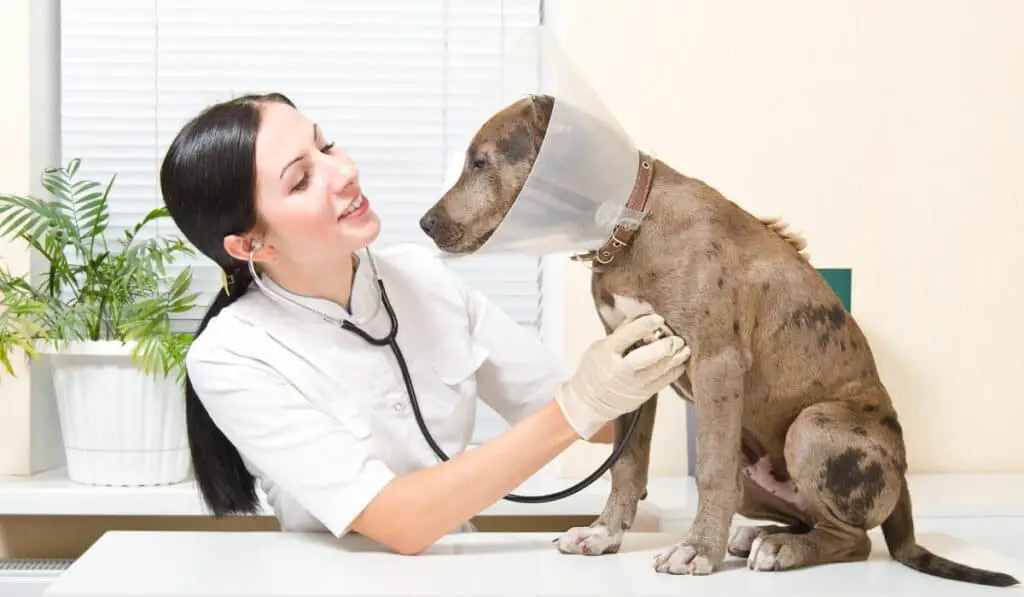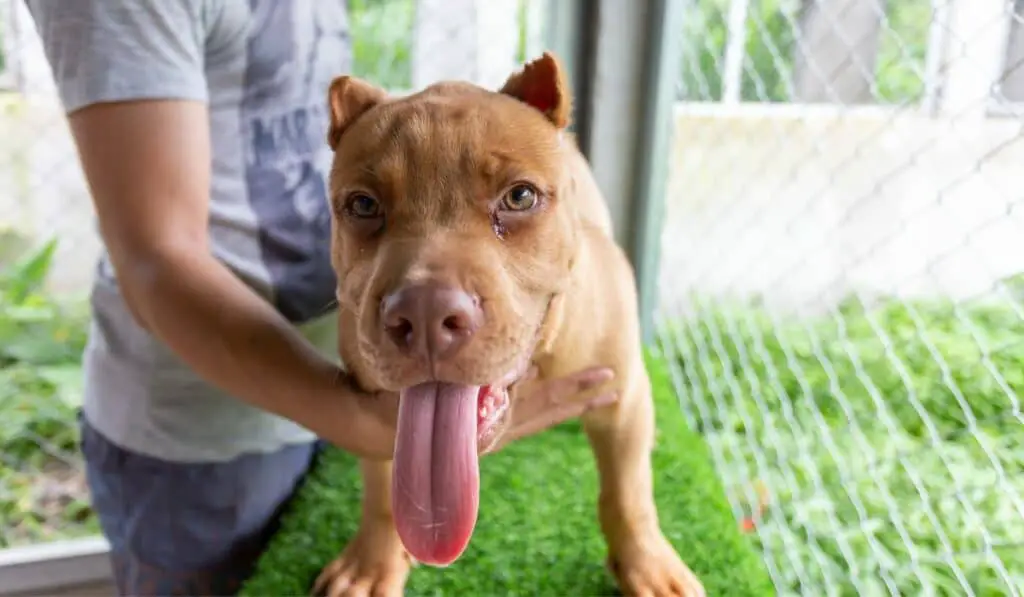Having a Pitbull, you must have found their hair anywhere – clothes, sofa, bed, etc. Just like humans, dogs shed their hair throughout their lives.
Shedding in dogs is common and natural. It is the way for dogs to get rid of old, unneeded hair or damaged hair. Certain dog breeds even grow thicker coats as winter comes, then shed them in spring for better body temp regulation.
However, hair loss in dogs can also be due to unnatural reasons, especially when the hair loss is centralized in one or more specific spots.
In this article, we will explain the causes of why your pitbull is losing hair. Hopefully, you can get the right solution and medical treatment for your furry friends.
Common Reasons Why Is My Pitbull Losing Hair
Hair loss in dogs is common and obvious. It usually appears either in one spot, in patches, or worse, the whole body. In general, numerous reasons can cause your Pitbull to lose its hair, which includes alopecia.

Regardless of what causes hair loss, it is treatable as long as you notice it earlier. Now, let’s look into some common reasons why your pitbull is losing hair.
1. Mange And Other Parasites
Mange is a skin disease that is caused by mites. These microscopic organisms live on the skin’s surface or in hair follicles. They burrow or chew on the skin, causing hair loss and itchiness to the infected dog.
Another parasite that commonly causes hair loss in dogs is fleas. Fleas can trigger unstoppable itchiness in dogs to the point they will scratch their hair off.
Mites and fleas are highly contagious. By the time you see bald patches on your pitbull, chances are these parasites have spread throughout the household. Besides, some parasites like scabies mites can infect humans.
This is to say, immediate medical attention is necessary. Get your dog an antiparasitic medication when you see signs of mites and fleas. Additionally, get tips from the vet on ways to effectively eliminate pests from your house.
2. Bacterial And Fungal Infections
Here an interesting fact, yeast and bacteria are normal inhabitants of dog skin and usually won’t cause harm to the dogs. However, they can create a nasty infection when they grow out of control.
Bacterial and yeast infection causes itchiness, redness, odor, and hair loss in dogs. Some bacterial infections may get nastier, like the pyoderma that creates pus-filled pimples on the skin.
Tinea (ringworm) on the other hand, is not a normal inhabitant of a dog. It’s a type of fungus that causes dry skin and hair loss on the infected spot.
Regardless of which infection your pitbull may get, a trip to the veterinarian is a must, especially when you see red, itchy or scaly patches on their skin. The vet will run a full examination and do some tests, proceed with prescribing antibiotic or antifungal drugs for the infection.
3. Allergies
Dogs can develop allergies too, with the main culprit being environmental allergies. Any irritants like pollen, dust mites, mold, flea, and food allergies are the most frequent triggers for allergy in dogs.

Once your pitbull is confirmed to have an allergy, the vet will prescribe medicines to relieve the symptoms. Some allergy tests might need to be done to find out the triggers and to rule out the possibility of food allergy.
If indeed the food is the culprit, it is important to make a change in your dog’s diet. Depending on what ingredient triggers the reaction, your vet will be able to give the best advice on what is the best food for dog allergies.
4. Seasonal Shedding
Occasionally, extreme hair loss in dogs can just be normal shedding. As stated before, dogs shed their fur when the hair is old or damaged, or due to seasonal changes. Besides, dogs shed all year round. Depending on the breeds, the amount of hair shed varies.
However, if you notice your fur baby is shedding out of control, the best possible way is to brush your dog a couple times a week. Brushing your fur baby on a regular basis helps to remove and control excess hair. Needless to say, you will need to use a brush that suits your pitbull.
5. Underlying Medical Conditions
If everything else has been eliminated and your pitbull is still losing hair, high chances are it caused by underlying medical conditions.
Pitbulls are prone to a medical condition called hypothyroidism, a condition where the body doesn’t create sufficient thyroid hormone.
As a result, they will have dry skin and coat, experience hair loss, and be inclined to skin diseases. In addition, you might notice your pitbull to have some behavioral changes, like aggression.
Hence, it is important to visit the vet as soonest possible when you notice changes in your dog. Early tests can help to determine the causes so as to get the right treatment.

Get the 7 Biggest Training Mistakes free report!
How Can You Help Your Pitbull With Hair Loss?
Don’t lose hope! Fortunately, you can do a few practical solutions if your Pitbull is experiencing hair loss.
Natural Remedies
You can make a few natural remedies at home to stimulate hair growth. For instance, you can wipe your Bully’s coat with lemon juice, as it has citric acid that has awesome antibacterial properties. It will also help lessen the effects of infection.

You can also apply some aloe vera to your dog’s body, as it’s rich in natural enzymes that help eliminate dead skin cells and support hair growth.
Regular Bathing
Bathing is another crucial part of a pup’s grooming routine, as it keeps your pitbull from smelling bad and lessens the chances of having skin infections.
Nonetheless, we do not recommend bathing your dog often as it can strip the coat of its natural essential oils, making their hair brittle, dry, and more likely to fall out. That can also lead to itchiness and skin irritation.
Regular Brushing
Did you know brushing is another vital part of your Pitbull’s grooming routine? It helps remove any loose hair and dead skin.
Furthermore, it helps distribute the natural essential oils the dog’s coat generates to keep it healthy and lessen shedding.
We suggest brushing your dog’s coat daily or about twice a week. Ensure you use a soft brush to prevent irritating the skin and move the brush in a circular motion over the coat to support blood circulation.
High-Quality Diet
Make sure your Pitbull’s diet has a rich amount of protein. Remember that hair is about ninety percent of protein. That will help control too much shedding and strengthen the hair follicles. You can add foods containing omega-6 and omega-3 fatty acids.
Pitbull Losing Hair – FAQ
Is A Pitbull Prone To Hair Loss?
Like all dogs, Pitbulls have hair that could fall out. Nonetheless, the breed isn’t particularly known for excessive hair loss.
Other Pitbulls may have a genetic predisposition to thinning hair or hair loss, but this isn’t common among the breed.
It’s essential to note that hair loss could be caused by different factors, like medical conditions, allergies, or poor diet. It is best to consult a vet to identify the cause and design an appropriate treatment plan.
When Does Pet Hair Loss Become A Health Concern?
Do you feel that your Pitbull is shedding more than a normal amount? Your first account is to schedule a visit to your vet. They can help identify if your dog’s hair loss is part of the normal shedding process or a sign of an underlying issue, such as poor nutrition, stress, or another medical concern.

Your vet will note the distribution or pattern of hair loss on your furry friend and investigate if the hair is broken off or shedding from the hair follicle.
They will also look for symptoms of secondary dry skin infections or parasites and may do skin scrapings to send to the laboratory for testing. Also, your vet can make necessary recommendations on if your Pitbull needs medical treatment or a better deshedding brush.
Final Thoughts
You can’t stop a healthy Pitbull from a normal amount of shedding, but the above tips must be preferable to your dog having a medical reason for losing their hair.
Make sure you stay on the lookout for any symptoms of abnormal hair loss, and continue taking your Pitbull for regular wellness exams.
